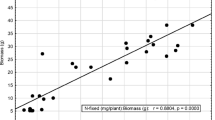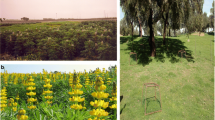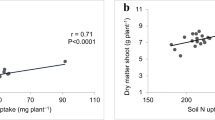Abstract
A survey of N2 fixation in farmers’ fields of Northern (>1,000 mm rainfall), Central (800–1,000 mm rainfall), and Southern (<800 mm rainfall) Zambia revealed some significant differences in plant growth and symbiotic performance of different food grain legumes. Of the three grain legumes (i.e., Bambara groundnut (Vigna subterranea L. Verdc.), cowpea (Vigna unguiculata L. Walp.), and groundnut (Arachis hypogaea L.)) grown in Southern Zambia, cowpea showed greater shoot biomass and significantly lower shoot δ15N values than groundnut and Bambara groundnut. The lower shoot δ15N resulted in greater %Ndfa (59%) in shoots and higher amounts of N-fixed, whether per square meters (6,394.0 mg N), per plant (650.8 mg N), or per hectare (63.9 kg N) relative to groundnut and Bambara groundnut, even though the number of cowpea plants per square meter was significantly lower than that of groundnut or Bambara groundnut. Although the shoot δ15N values of cowpea, Bambara groundnut and common bean (Phaseolus vulgaris L.) were significantly lower than those of groundnut in Central Zambia and their %Ndfa values, therefore, greater, the higher number of groundnut plants per square meter resulted in significantly greater shoot N content, as well as N-fixed per square meter and per hectare relative to the other species. Despite having similar plant density as cowpea in Central Zambia, common bean could fix only 6.0 kg N ha−1 compared with 35.4 kg N ha−1 by cowpea. In Northern Zambia, Bambara groundnut showed the lowest mean shoot δ15N value (0.54 ± 0.3‰), followed by groundnut (1.59 ± 1.0‰), and then common bean (the three grain legumes grown in that region). As a result, %Ndfa and N-fixed were significantly greater in groundnut (69.7% and 566.0 mg N per plant) and Bambara groundnut (62.9% and 440.1 mg N per plant) than in common bean (2.6% and 2.4 mg N per plant). In Northern Zambia, groundnut, Bambara groundnut and common bean fixed 78.7, 67.6, and 0.9 kg N ha−1, respectively, even though the plant density per square meter of common bean (which fixed the lowest amount of N per hectare) was twice that of groundnut and Bambara groundnut. A species × site analysis showed that cowpea fixed relatively greater amounts of N per plant, per square meter, and per hectare in Southern than Central Zambia. Bambara groundnut and common bean also had significantly lower δ15N values and higher %Ndfa in Central than Northern Zambia.
Similar content being viewed by others
References
Adjei-Nsiah S, Kuyper TW, Leeuwis C, Abekoe MK, Cobbinah J, Sakyi-Dawson O, Giller KE (2008) Farmers’ agronomic and social evaluation of productivity, yield and N2-fixation in different cowpea varieties and their subsequent residual N effects on succeeding maize crop. Nutr Cycl Agroecosyt 80:199–209
Adu-Gyamfi JJ, Mayaka FA, Sakala WD, Odgaard R, Versterager JM, Hogh-Jensen H (2007) Biological nitrogen fixation and phosphorus budgets in farmer-managed intercrops of maize-pigeon pea in semi-arid South and Eastern Africa. Plant Soil 295:127–136
Ayisi KK, Nkgapele RJ, Dakora FD (2000) Nodule formation and function in six varieties of cowpea (Vigna unguiculata L. Walp.) grown in a nitrogen-rich field soil in South Africa. Symbiosis 28:17–31
Bado BV, Bationo A, Cescas MP (2006) Assessment of cowpea and groundnut contributions to soil fertility and succeeding sorghum yields in Guinea savannah zone of Burkina Faso (West Africa). Biol Fert Soils 43:171–176
Dakora FD (1985a) Biological nitrogen fixation in Ghana. In: Ssali H, Keya SO (eds) Biological nitrogen fixation in Africa, Rhizobium. MIRCEN, Nairobi, pp 59–71
Dakora FD (1985b) Nodulation and nitrogen fixation by groundnut in amended and unamended field soil in Ghana. In: Ssali H, Keya SO (eds) Biological nitrogen fixation in Africa, Rhizobium. MIRCEN, Nairobi, pp 324–339
Dakora FD, Keya SO (1997) Contribution of legume nitrogen fixation to sustainable agriculture in Sub-Saharan Africa. Soil Biol Biochem 29:809–817
Dakora FD, Phillips DA (2002) Root exudates as mediators of mineral acquisition in low-nutrient environments. Plant Soil 245:35–47
Dakora FD, Aboyinga RA, Yahaya M, Apaseku J (1987) Assessment of N2 fixation in groundnut (Arachis hypogaea L.) and cowpea (Vigna unguiculata L. Walp.) and their relative N contribution to succeeding maize crop in Northern Ghana. MIRCEN J 3:389–399
Division of Chemical Services (1956) Analytical methods. Division of Chemical Services. Department of Agriculture, Pretoria
Du Plessis SF, Burger RDT (1964) A comparison of Chemical extraction methods for the evaluation of phosphate availability of top soils. South Afr J Agric Sci 8:11–13
Dyer B (1894) On the analytical determinations of probably available mineral plant-food in soil. J Chem Soc 65:1–15
Eaglesman ARJ, Ayanaba A, Ranga Rao V, Eskew DL (1981) Improving the nitrogen nutrition of maize by intercropping with cowpea. Soil Biol Biochem 13:169–171
Naab JB, Chimphango MB, Dakora FD (2009) N2 fixation in cowpea plants grown in farmers’ fields in the Upper west Region of Ghana, measured using 15 N natural abundance. Symbiosis 48:37–46
Ncube B, Twomlow SJ, Van Wijk MT, Dimes JP, Giller KE (2007) Productivity and residual benefits of grain legumes to sorghum under semi-arid conditions in southwestern Zimbabwe. Plant Soil 299:1–15
Nyemba RC, Dakora FD (2005) Identifying suitable arable weeds as reference plants for measuring N2 fixation. Symbiosis 40:79–86
Ojiem JO, Vanlauwe B, de Ridder N, Giller KE (2007) Niche-based assessment of contribution of legumes to nitrogen economy of Western Kenya smallholder farm. Plant Soil 292:119–135
Shearer G, Kohl DH (1986) N2 fixation in field settings: estimates based on natural 15 N abundance. Aust J Plant Physiol 13:699–756
Unkovich MJ, Pate JS, Sanford P (1993) Preparation of plant samples for high precision nitrogen isotope ratio analyses. Comm Soil Sci Plant Anal 24:2093–2106
Unkovich MJ, Pate JS, Armstrong EL, Sanford P (1994) Selection of reference plants for 15 N natural abundance assessment of N2 fixation by crop and pasture legumes in South-west Australia. Aust J Agric Res 45:133–147
Veldcamp WJ, Muchinda M, Delmotte AP (1984) Agro-climate zones in Zambia. Soil Bulletin No. 9. Soil Survey Unit, Research Branch. Ministry of Agriculture, Food and Fisheries, Lusaka
Vincent JM (1970) A manual for the practical study of the root-nodule bacteria. IBP Handbook No. 15. Blackwell, Oxford
Wakley A, Black IA (1938) Determination of organic matter in soil by chromic acid digestion. Soil Sci 63:251–264
Acknowledgements
Felix Dakora is grateful to the National Research Foundation, the South African Research Chair in Agrochemurgy and Plant Symbioses, and the Tshwane University of Technology for continued support of his research.
Author information
Authors and Affiliations
Corresponding author
Additional information
Ronnie C. Nyemba Posthumous
Rights and permissions
About this article
Cite this article
Nyemba, R.C., Dakora, F.D. Evaluating N2 fixation by food grain legumes in farmers’ fields in three agro-ecological zones of Zambia, using 15N natural abundance. Biol Fertil Soils 46, 461–470 (2010). https://doi.org/10.1007/s00374-010-0451-2
Received:
Revised:
Accepted:
Published:
Issue Date:
DOI: https://doi.org/10.1007/s00374-010-0451-2




